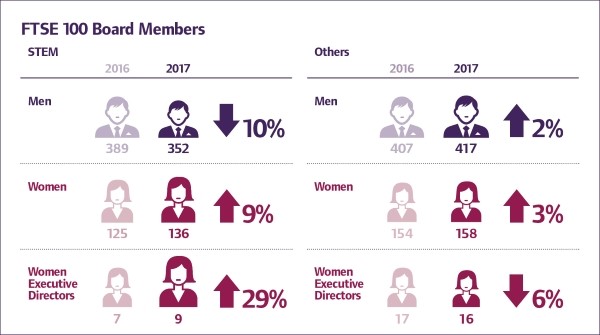The UK’s top companies continue to increase the representation of women on their boards. Of the companies listed on the FTSE 100, 46 are classified as STEM and 54 as non-STEM.

Towards gender balance on boards
- In STEM companies, the percentage of women on boards increased to 28% from 24%
- 67% of STEM companies have achieved 25% representation of women on their boards, the voluntary target set by the Davies review
- 26% have reached the new voluntary target of 33% that was set in the closing of the Davies review (33% is believed to be the critical mass for women to start making a significant difference)
Other companies in the FTSE 100 are doing better than those in STEM sectors.
Executive board roles
Boards have been slower to increase representation of women in executive positions.
- In 2016, there were seven women executive directors in six companies. In 2017 this increased to nine women executive directors in eight companies
- 9% of STEM companies have 33% or more women on executive committees, compared to 20% of other companies
FTSE 250
- 23% of board roles in the FTSE 250 are held by women. 60% of these companies have less than 25% representation of women on their boards.
Women to watch
Thanks to suggestions from WISE, the 2017 list of women to watch includes more women with a science, technology and engineering background.
WISE corporate members are using the Ten Steps framework to nurture talented women in their organisations and provide opportunities for them to take up roles on the board.
Source
WISE analysis of data from the Cranfield University School of Management Female FTSE report 2017. The report ranks FTSE companies according to the percentage of Board directorships that are held by women.
